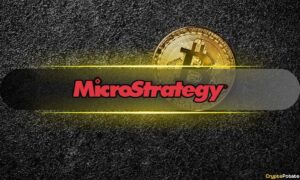Bitcoin bulls should stay away from the new microstrategy ETF

Bitcoin (BTC) billionaire Michael Saylor should steer clear of his new MicroStrategy (MSTR) exchange-traded fund (ETF). ETFs take unnecessary risks and BTC is guaranteed to underperform over time. There are better ways to bet on BTC.
In the year On August 15, Defiance ETFs – an asset manager focused on “exposure to disruptive companies without the need for margin accounting” – launched the Defiance Daily Target 1.75X Long MSTR ETF (MSTX). The amount reached $22 million on the first day.
According to Defiance, MSTX is “the first single-stock long leveraged ETF for microstrategy” and seeks to “provide 175% long daily target exposure to the stock.” In practice, that means adding risky leverage to an already concentrated and speculative investment. The risk is not worth it.
Business Intelligence Firm or Bitcoin Hedge Fund?
Originally a business intelligence firm, MicroStrategy turned into a de facto cryptocurrency hedge fund in 2020 when founder Michael Saylor started using the company's balance sheet to buy BTC.
Related: Expect Bitcoin ETF Options to Launch Before 2025
The strategy paid off. Over the past four years, MSTR shares are up nearly 1,000%. The stock outperformed BTC by 50%, more than doubling the returns of investment legend Warren Buffett's Berkshire Hathaway.
Since then, MicroStrategy has doubled in size. In its August 1 earnings call, MicroStrategy announced that it is adopting a new lodestar for corporate performance: “Bitcoin Yield”, BTC-per-share.
The premise is that, as a public company, MicroStrategy will strategically leverage its balance sheet — primarily by borrowing or issuing shares — to accumulate BTC in a way that gradually improves its BTC-per-share ratio, benefiting shareholders.

The idea makes sense, especially given the price of MSTR's bubble stock. Many companies – especially meme stocks – cash in on the excitement of raising cheap capital and investing in valuable assets. That's exactly what GameStop did in June, when it raised $2 billion after a speculative frenzy sent shares soaring 400 percent.
The problem is that a good corporate treasury strategy does not equate to a smart BTC play. In fact, MicroStrategy's high share price makes it more difficult than ever for the stock to grow BTC.
Related: Ethereum Gas Fees: Too Low or Too High? No one can decide.
Benchmark fintech analyst Mark Palmer If BTC reaches $150,000 in 2025, MSTR will be worth $2,150 per share (or $215 per share after MSTR's 10-for-1 stock split on August 9th). [MicroStrategy] In the next 1.5 years, Bitcoin will continue to accumulate significantly and the price of Bitcoin will reach $150,000, Palmer told Cointelegraph in an email.
In the year August 2024 The stock is trading around $132, which means Palmer predicts that a 300% increase in BTC's spot price would eclipse MSTR shares by just 60%.
Don't forget: despite the BTC buying binge, MicroStrategy is still a real company – and its enterprise software business isn't doing well. Microstrategy's second-quarter revenue was down 7 percent from last year. With sick trading and speculative balance, MSTR is a solid investment play.
Use it
Meanwhile, the microstrategy approach is fraught with risks. As of June 30, the company has more than $3.7 billion in debt on its balance sheet. If BTC's price action turns bearish – as it often does – MSTR can take a disproportionate effect.
Defiance's leveraged ETF takes those risks and compounds them. A micro strategy is a bet that has already been used on BTC. The Defiance ETF calls that risk at 1.75x.
To make matters worse, leveraged ETFs don't feature comparable investments below the minimum threshold. The MSTX ETF does not actually hold MSTR shares. It holds a basket of derivatives – called swaps – to engineer exposure to the MSTR price. Maintaining a daily target means rebalancing holdings on a regular basis, which essentially results in a “buy high sell low” trading strategy. (Other leveraged BTC ETFs can be scratched from the list for the same reason).
The Defiance ETF's 1.29% annual management fee carries another additional dividend. By comparison, spot BTC ETF management fees generally range from 0.15% to 0.25%, and issuers waive those fees entirely for the first six months to a year of listing.
The best options for Bitcoin bulls
Vanilla spot BTC ETFs – such as Fidelity Wise Origin Bitcoin Fund (FBTC) and iShares Bitcoin Trust (IBIT) – offer more than enough BTC price exposure for most investors. Traders looking to double down on BTC are better off buying BTC futures directly on the exchange.
Bitcoin “micro” futures — small contracts with small minimum buy-in — are proliferating on futures exchanges, including Coinbase Derivatives and the Chicago Mercantile Exchange (CME). Without daily balance, futures are more suitable as long-term holdings then leveraged ETFs.
Options on BTC ETFs may also be launched soon, and could create another attractive option. (As always, you should do your own research before investing in a future – or you'll lose money.)
Microstrategy's Saylor urges investors to become “triple maxi” bitcoin bulls and go all-in on BTC. The advice is questionable. If you're betting big on BTC, you need all the luck you can get. On your own with a backed ETF.
Alex O'Donnell is a senior writer for Cointelegraph. He previously founded DeFi developer Umimi Labs and worked as a financial journalist at Reuters for seven years, where he covered M&A and IPOs. He is the crypto development leader at Startup Accelerator Expert Dojo.
This article is not intended for general information purposes and should not be construed as legal or investment advice. The views, ideas and opinions expressed herein are solely those of the author and do not necessarily represent the views and opinions of Cointelegraph.













